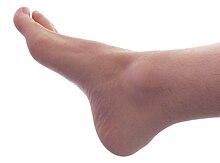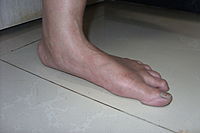Flat feet
This article is written like a manual or guide. (November 2020) |
| Flat feet | |
|---|---|
| Other names | Pes planus, fallen arches |
Orthopedics
Podiatry | |
Flat feet, also called pes planus or fallen arches, is a postural deformity in which the arches of the foot collapse, with the entire sole of the foot coming into complete or near-complete contact with the ground. Sometimes children are born with flat feet (congenital). There is a functional relationship between the structure of the arch of the foot and the biomechanics of the lower leg. The arch provides an elastic, springy connection between the forefoot and the hind foot so that a majority of the forces incurred during weight bearing on the foot can be dissipated before the force reaches the long bones of the leg and thigh.[1]
In pes planus, the head of the talus bone is displaced medially and distal from the navicular bone. As a result, the plantar calcaneonavicular ligament (spring ligament) and the tendon of the tibialis posterior muscle are stretched to the extent that the individual with pes planus loses the function of the medial longitudinal arch (MLA). If the MLA is absent or nonfunctional in both the seated and standing positions, the individual has "rigid" flatfoot. If the MLA is present and functional while the individual is sitting or standing up on their toes, but this arch disappears when assuming a foot-flat stance, the individual has "supple" flatfoot. This latter condition is often treated with arch supports.[1]
Children


Studies have shown flat feet are a common occurrence in
.Diagnosis
Since children are unlikely to suspect or identify flat feet on their own, it is important for adult caregivers to check on this themselves. Besides visual inspection of feet and of the treadwear pattern on shoe soles, caregivers should notice when a child's gait is abnormal, or the child seems to be in pain from walking. Children who complain about calf muscle pains, arch pain, or any other pains around the foot area may be developing or have developed flat feet. A systematic review and meta-analysis study by Xu, et.al., found that urban sedentary boys, aged 6–9, were frequently diagnosed with flatfeet. The researchers also explored and listed additional risk factors that played a role in diagnosing flatfeet.[5]
-
Lateral X-ray of a flat foot with C-sign, which is a bony bridge between thesustentaculum tali, in combination with a prominent inferior border of the sustentaculum tali. This represents a talocalcaneal coalition, which is an abnormal connection between the talus and calcaneus and is thought to cause the flat foot deformity in this case.[6]
Treatment
Training of the feet, utilizing
Adults
Flat feet can also develop as an adult ("adult acquired flatfoot") due to injury, illness, unusual or prolonged stress to the foot, faulty biomechanics,[9] or as part of the normal aging process. This is most common in women over 40 years of age. Known risk factors include obesity, hypertension and diabetes.[10] Flat feet can also occur in pregnant women as a result of temporary changes due to increased elastin (elasticity) during pregnancy; if developed by adulthood, flat feet generally remain flat permanently.


If a youth or adult appears flatfooted while standing in a full
Pathophysiology
Research has shown that tendon specimens from people who have adult-acquired flat feet show evidence of increased activity of
Diagnosis
Many medical professionals can diagnose a flat foot by examining the patient standing or just looking at them. On going up onto tip toe the deformity will correct when this is a flexible flat foot in a child with lax joints. Such correction is not seen in adults with a rigid flat foot.[citation needed]
An easy and traditional home diagnosis is the "wet footprint" test, performed by wetting the feet in water and then standing on a smooth, level surface such as smooth concrete or thin cardboard or heavy paper. Usually, the more the sole of the foot that makes contact (leaves a footprint), the flatter the foot. In more extreme cases, known as a kinked flatfoot, the entire inner edge of the footprint may actually bulge outward, where in a normal to high arch this part of the sole of the foot does not make contact with the ground at all.[citation needed]
On
-
Dorsoplantarprojectional radiographof the foot showing the measurement of the talonavicular coverage angle.
-
Weight-bearing lateral X-ray showing the measurement of calcaneal pitch, which is an angle of the calcaneus and the inferior aspect of the foot, with different sources giving different reference points.[13] A calcaneal pitch of less than 17° or 18° indicates flat feet.[11]
-
Same lateral X-ray showing the measurement of Meary's angle, which is the angle between the long axis of the talus and first metatarsal bone.[11] An angle greater than 4° convex downward is considered a flat foot, 15° - 30° moderate flat foot, and greater than 30° severe flat foot.[11]
Treatment
Most flexible flat feet are asymptomatic, and do not cause pain. In these cases, there is usually no cause for concern. Flat feet were formerly a physical-health reason for service-rejection in many militaries. However, three military studies on asymptomatic adults (see section below), suggest that persons with asymptomatic flat feet are at least as tolerant of foot stress as the population with various grades of arch.[citation needed]
In a study performed to analyze the activation of the tibialis posterior muscle in adults with pes planus, it was noted that the tendon of this muscle may be dysfunctional and lead to disabling weightbearing symptoms associated with acquired flat foot deformity. The results of the study indicated that while barefoot, subjects activated additional lower-leg muscles to complete an exercise that resisted foot adduction. However, when the same subjects performed the exercise while wearing arch supporting orthotics and shoes, the tibialis posterior was selectively activated. Such discoveries suggest that the use of shoes with properly fitting, arch-supporting orthotics will enhance selective activation of the tibialis posterior muscle thus, acting as an adequate treatment for the undesirable symptoms of pes planus.[14]
Rigid flatfoot, a condition where the sole of the foot is rigidly flat even when a person is not standing, often indicates a significant problem in the bones of the affected feet, and can cause pain in about a quarter of those affected.
Treatment of flat feet may also be appropriate if there is associated foot or lower leg pain, or if the condition affects the knees or the lower back. Treatment may include foot gymnastics or other exercises as recommended by a podiatrist or physical therapist. In cases of severe flat feet, orthoses should be used through a gradual process to lessen discomfort. Over several weeks, slightly more material is added to the orthosis to raise the arch. These small changes allow the foot structure to adjust gradually, as well as giving the patient time to acclimatize to the sensation of wearing orthoses. In some cases, surgery can provide lasting relief, and even create an arch where none existed before; it should be considered a last resort, as it is usually very time-consuming and costly.[18] A minimally-invasive surgical intervention involving a small implant is also available. The implant is inserted into the sinus tarsi and prevents the calcaneus and talus from sliding relative to each other. This prevents the sinus tarsi from collapsing and thus prevents the external symptom of the fallen arch from occurring.[19]
Athletic performance

The effects of flat feet fall under two categories, which are asymptomatic and symptomatic. Individuals with rigid flat feet tend to exhibit symptoms such as foot and knee tendonitis, and are recommended to consider surgical options when managing symptoms. Individuals with flexible flat generally exhibit asymptomatic effects in response to their flat feet.[2]
According to AAP news and journal gateway, being flexibly flat-footed does not impede athletic performance.[20]
It is generally assumed by running professionals (primarily including some physical trainers, podiatrists, and shoe manufacturers) that a person with flat feet tends to
Military performance
Studies analyzing the correlation between flat feet and physical injuries in soldiers have been inconclusive, but none suggest that flat feet are an impediment, at least in soldiers who reached the age of military recruitment without prior foot problems.
A 2005 study of Royal Australian Air Force recruits that tracked the recruits over the course of their basic training found that neither flat feet nor high arched feet had any impact on physical capability, injury rates or bipedal aptitude. Although there have been results rendered from military trials that have shown those with flat feet to have fewer injuries.[24]
No current studies have been successful in fully ascertaining the chronic, long-term detriments to health that are caused by the overexertion (of which is necessary for athletes/soldiers performing with flat feet) and other compensating measures commonly enacted by the body during bipedal movement.
Another divergent study of 295 Israel Defense Forces recruits found that those with high arches had almost four times as many stress fractures as those with the lowest arches.[25]
A later study of 449 U.S. Navy special warfare trainees found no significant difference in the incidence of stress fractures among sailors and Marines with different arch heights.[26]
See also
- Planovalgus deformity
- Marfan syndrome
- Ehlers-Danlos syndrome
- Comparison of orthotics
- Rocker-bottom feet
References
- ^ PMID 3575426.
- ^ PMID 19963167.
- S2CID 33684466.
- ^ "Dyspraxia in Adults". www.dyspraxiafoundation.org.uk. 3 October 2013.
- PMID 35886097.
- S2CID 16663986. (CC BY 4.0)
- PMID 1624509– via (quoted in) www.unshod.org/pfbc/pfmedresearch.htm.
- ^ "Five Things Physicians and Patients Should Question" (PDF). Choosing Wisely. Retrieved 15 February 2018.
- ^ "Flat feet: MedlinePlus Medical Encyclopedia". medlineplus.gov. Retrieved 2022-11-18.
- ^ a b "Advance toward treatment for painful flat feet". ScienceDaily. 2012-01-11.
- ^ a b c d e f "Pes Planus". University of Washington, Department of Radiology. Last modified: 14 August 2016
- ^ Bell DJ, Weerakkody Y. "Pes planus". Radiopaedia. Retrieved 2018-03-01.
- ^ Detailed explanations and references are located in the Calcaneal pitch article.
- PMID 15632663.
- ^ "Fallen Arch". Health A to Z. Aetna InteliHealth(R). 2007-12-18. Archived from the original on 2008-08-03. Retrieved 2008-05-27.
Unlike a flexible flatfoot, a rigid flatfoot is often the result of a significant problem affecting the structure or alignment of the bones that make up the foot's arch.
- ^ "Flatfoot". Bone, Joint and Muscle Conditions: Flatfoot. Seattle Children's Hospital. 2008-07-29. Retrieved 2008-05-27.
About one in four people with rigid flatfoot has pain and disability.
- ^ "Rheumatoid Arthritis in Feet - Academic Association of Medicine". aaom.org. 27 February 2018.
- ^ "Flat Feet – Everything You Should Know – The Shoes For Me". theshoesforme.com. 16 October 2015.
- ^ "Can The HyProCure Implant Provide The Answer For Hyperpronation?". podiatrytoday.com.
- S2CID 9891114.
- ^ "Pronation, Explained." Runner's World. August 2004.
- ^ "Running Shoes for Flat Feet." ShoeGuide.Org. February 2020.
- S2CID 24812917.
- PMID 16130646.
- ^ Giladi M, Milgrom C, Stein M, et al. "The low arch, a protective factor in stress fractures: a prospective study of 295 military recruits". Orthop Rev 1985; 14:82–84.
- PMID 12762095.



![Weight-bearing lateral X-ray showing the measurement of calcaneal pitch, which is an angle of the calcaneus and the inferior aspect of the foot, with different sources giving different reference points.[13] A calcaneal pitch of less than 17° or 18° indicates flat feet.[11]](http://upload.wikimedia.org/wikipedia/commons/thumb/8/82/Calcaneal_pitch.jpg/713px-Calcaneal_pitch.jpg)
![Same lateral X-ray showing the measurement of Meary's angle, which is the angle between the long axis of the talus and first metatarsal bone.[11] An angle greater than 4° convex downward is considered a flat foot, 15° - 30° moderate flat foot, and greater than 30° severe flat foot.[11]](http://upload.wikimedia.org/wikipedia/commons/thumb/4/46/Talar-1st_metatarsal_angle_%28Meary%27s_angle%29.jpg/583px-Talar-1st_metatarsal_angle_%28Meary%27s_angle%29.jpg)